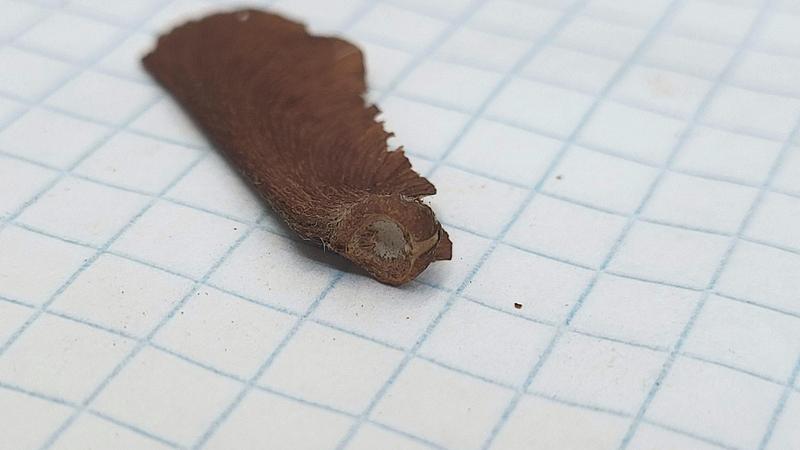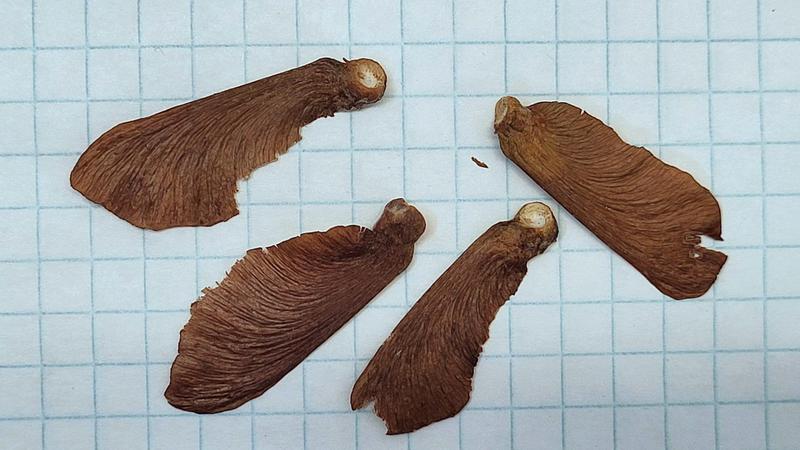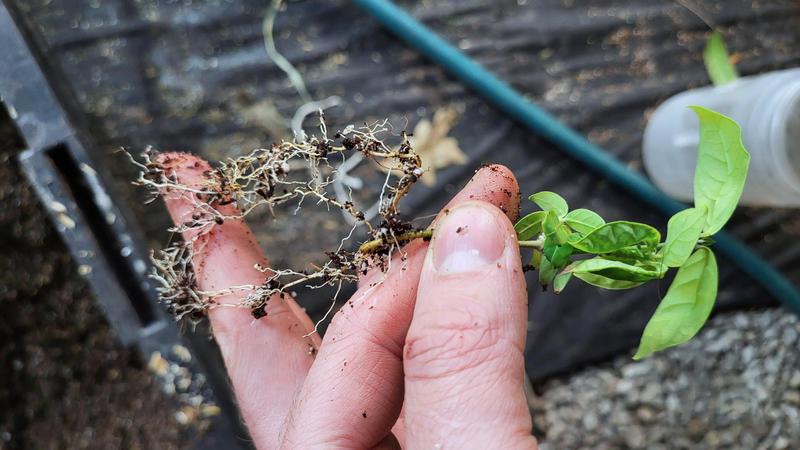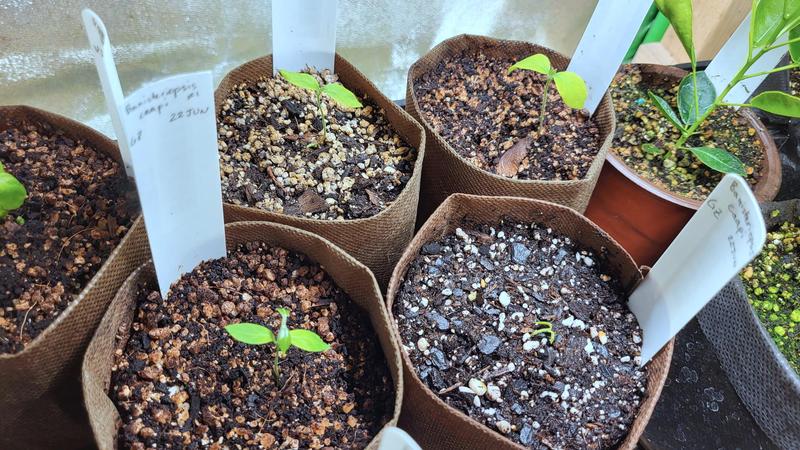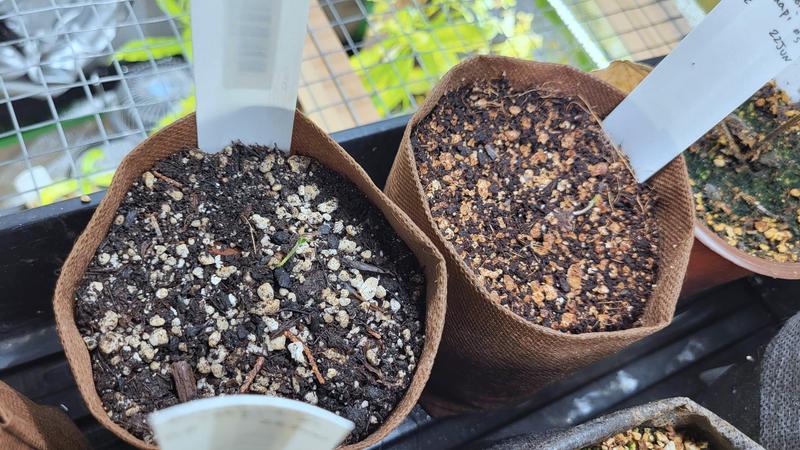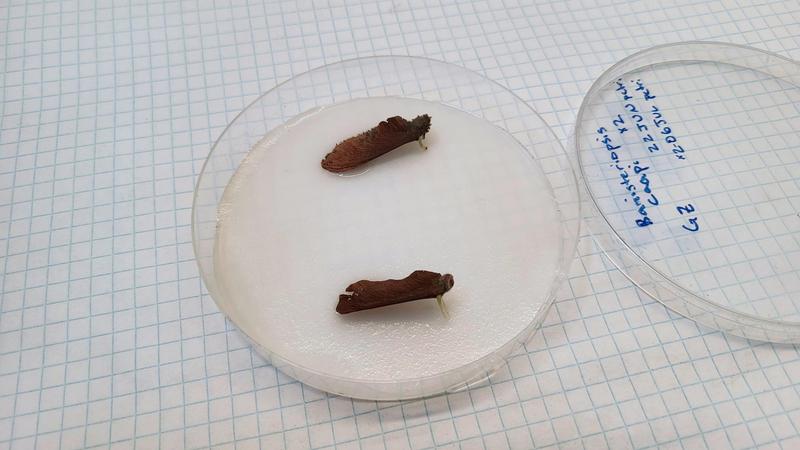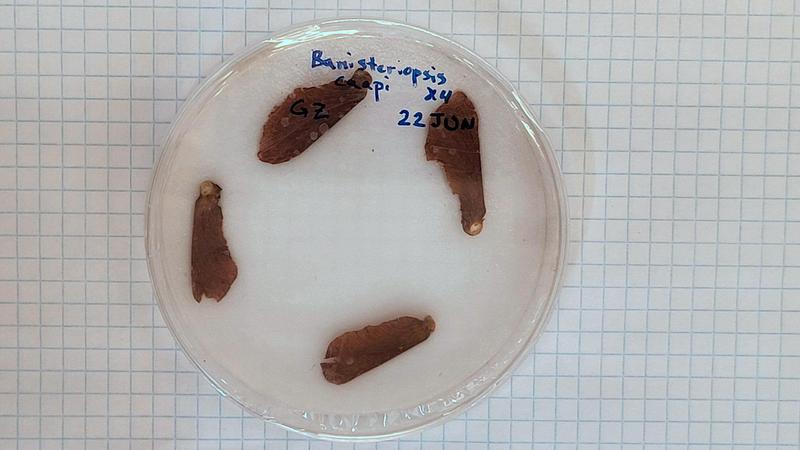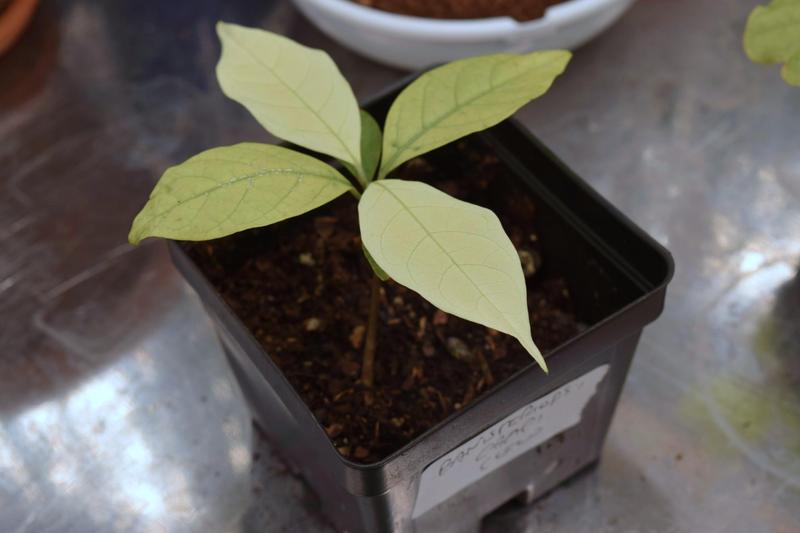Banisteriopsis caapi
Propagation
Germination
| media | germination | temperature °C | note | reference |
|---|---|---|---|---|
The most common recommendation for germination is to plant seeds one-seed-width deep in soil with the wing facing upwards, though it is unclear how this method was derived or tested.[2][3] There is some pictorial success using this method.[4][5]
Vegetative
Caapi can be propagated by cuttings in 1:1 soil:sand in polyethylene bags without the use of hormones.[6]
In-Vitro
| basal media | supplements | source | target | note | reference |
|---|---|---|---|---|---|
| MS | 30 g/l sucrose; 4 g/l phytagel; 0.1 ppm BAP | apical/axillary buds | multiplication | micropropagation | [6] |
| MS | 30 g/l sucrose; 4 g/l phytagel; 0.1 ppm IAA | apical/axillary buds | rooting | micropropagation | [6] |
Explant disinfection using 2% sodium hypochlorite for both 60 and 80 minutes resulted in 60-70% of healthy shoots.[6]
BAP at a concentration of 0.1 ppm was successful at inducing multiplication (8 nodes in 31 days). One centimeter apical/axillary bud shoot explants increased to an average of 6.4 cm long with 9 leaves without callusing over the same period. A further 31 days in a 0.1 ppm IAA rooting media resulted in an average of two roots, five leaves, and three nodes per explant. No optimization of the media was conducted.[6]
Cultivation
| Planting density (m-2) | inter-row space (cm) | intra-row space (cm) | note | reference |
|---|---|---|---|---|
Harvest
Yield
| product | source | yield per season (kg/ha) | note | reference |
|---|---|---|---|---|
| product | source | yield per plant | note | reference |
|---|---|---|---|---|
Soilless
Soil
| soil type | pH | C-content % | precipitation | temperature (°C) | altitude (m) | note | reference |
|---|---|---|---|---|---|---|---|
Fertilization
| type | rate | time | note | reference |
|---|---|---|---|---|
Temperature
Lighting
| fixture type | photoperiod | illumination | note | reference |
|---|---|---|---|---|
Pests
Ecology
Morphology
| character | measurement | unit | notes | reference |
|---|---|---|---|---|
Roots
Stem
Leaves
Inflorescence
Seeds
Phytochemistry
| compound | source | concentration (mg/g dry weight) | note | reference |
|---|---|---|---|---|
[13] [14] [8] [15] [16] [17] [18] [19] [20] [21] [22] [23] [24] [25] [26] [27] [28] [29] [30] [31]
Infraspecific Variation
Biosynthesis
Distribution
Timecourse
Improvement
| trait | improvement status | reference |
|---|---|---|
Identification
| variety | description | reference |
|---|---|---|
Inheritance
Methods
| type | note | reference |
|---|---|---|
History & Society
[32] [33] [34] [35] [36] [1] [24] [37] [38] [39] [40] [41]
Work Log
06 Dec 2023
Another, much smaller, seedling at transplant.
05 Dec 2023
A young plant just before transplant showing the root size.
26 Jul 2023
Four seedlings have now been transferred.
13 Jul 2023
Transplanted the sprouted seedlings to coir/perlite 1:1 mix.
10 Jul 2023
06 Jul 2023
Transferred the sprouting seeds to a new petri dish.
05 Jul 2023
Some mold has developed in the petri dishes.
Despite the contamination, the first germination has occurred.
22 Jun 2023
Started 8 seeds in two groups: One light and one dark. Filter paper in petri dish in 30°C incubator. First dish contains four large seeds. Second dish is wrapped in aluminum foil and contains two small seeds and two large seeds. Two seeds remain in storage from GZ batch.
08 May 2021
Received a “Cielo” clone.
Bibliography
- R. M. Ph.D, Sacred Vine of Spirits: Ayahuasca. Inner Traditions / Bear & Co, 2005.
A compilation of writings on the chemical, biological, psychological, and experiential dimensions of Ayahuasca• Includes 24 firsthand accounts of Ayahuasca experiences and resulting life changes, including contributions from J. C. Callaway, Charles S. Grob, and Dennis J. McKenna• Discusses the medical and psychological applications of AyahuascaAyahuasca is a hallucinogenic Amazonian plant mixture that has been used for hundreds, perhaps thousands, of years by native Indian and mestizo shamans in Peru, Colombia, and Ecuador for healing and divination. Many Western-trained physicians and psychologists have acknowledged that this substance can allow access to spiritual dimensions of consciousness, even mystical experiences indistinguishable from classic religious mysticism.In Sacred Vine of Spirits: Ayahuasca Ralph Metzner, a pioneer in the study of consciousness, has assembled a group of authoritative contributors who provide an exploration of the chemical, biological, psychological, and experiential dimensions of ayahuasca. He begins with more than 20 firsthand accounts from Westerners who have used ayahuasca and then presents the history, psychology, and chemistry of ayahuasca from leading scholars in the field of psychoactive research. He concludes with his own findings on ayahuasca, including its applications in medicine and psychology, and compares the worldview revealed by ayahuasca visions to that of Western cultures.
- WSS, “How to Germinate Banisteriopsis Caapi Seeds | World Seed Supply,” World Seed Supply. Aug-2014.
https://www.worldseedsupply.com/how-to-germinate-banisteriopsis-caapi-seeds/.
Banisteriopsis caapi is a perennial vine native to the Amazon rainforest known for its role in South American ayahuasca ceremonies. These spiritual ceremonies have gone on for hundreds of years in the Amazonian Basin and still exist today to some degree. Today, banisteriopsis caapi is one of the most sought after plants by collectors of […]
- A. Parsons, “How To Grow Banisteriopsis Caapi From Seed,” Zamnesia Blog. Feb-2022.
https://www.zamnesia.com/blog-grow-banisteriopsis-caapi-seed-n1755.
Find out how you can grow Banisteriopsis caapi, the spirit vine from the Amazon rainforest, from seed at home. All the info inside at Zamnesia!
- Acrobatic_Ad9513, “Banisteriopsis Caapi Seedlings,” r/EthnoGardening. Feb-2022. www.reddit.com/r/EthnoGardening/comments/suqhuf/banisteriopsis_caapi_seedlings/.
- PlantsAddiction, “Banisteriopsis Caapi Seeds Germinating for My Bday🎉 ’Cielo’ and the Rare ’Trueno’ Variety, or Black Caapi.,” r/druggardening. Dec-2020. www.reddit.com/r/druggardening/comments/kgajqk/banisteriopsis_caapi_seeds_germinating_for_my/.
- P. P. Villegas, “Propagacion in Vitro De Ayahuasca (Banisteriopsis Caapi) Propagation in Vitro of Ayahuasca (Banisteriopsis Caapi),” InvestigacÍon Universitaria, vol. 4, no. 1, pp. 57–65, 2008.
One investigated the necessary disingectant concentrations for the process of introduction of the axillary yolks to conditions in Vitro, of equal way proved levels of regulators of growth like the Bencil aminopurina and the Acido Indioacetico for the phases of introduction, multiplication and rooting in conditions of weave culture. Determining itself that the use of concentrations of 2% of Hipochlorito of sodium with a time of exhibition of 80 minutes, was obtained 70% of free buds of contamination, of equal way determined that the BAP to a concentration of 0.1 ppm, generated the process of brotamiento and multiplication, whereas the apllication of 0.1 ppm of AIA, fomented the formation by roots of vitroplantas of ayahuasca.
- J. M. R. Thevenin and R. H. R. Sambuichi, “Phytogeography and Floristics of the Arbor Component in União Do Vegetal Territories Intended for the Cultivation of Banisteriopsis Caapi and Psychotria Viridis in Rondônia,” Raega - O Espaço Geográfico em Análise, vol. 49, no. 0, p. 42, Dec. 2020.
doi: 10.5380/raega.v49i0.67208.
The territorial expansion of Amazonian religions that make ritual use of Ayahuasca / Hoasca, in Rondônia, has been associated to the maintenance of forested areas and recovery of degraded areas associated with the cultivation of Banisteriopsis caapi [(SpruceexGriseb.) CV Morton] and Psychotria viridis (Ruiz & Pav.) in agroforestry systems (SAFs). The present research had as objective to carry out the floristic survey and to analyze the composition and structure of the arboreal component of the forest fragments and agroforestry of territorial areas of União do Vegetal, one of the Hoasca religious matrices, in each phytoecological region of its comprehension in Rondônia. For this, non-probabilistic samples were performed on 08 rural properties in the delimited territory. In the selected areas, disjoint plots of 50 x 20 m (0.1 ha) were plotted, totaling 23 plots and 2.3 ha of area sampled, and then phytosociological parameters were calculated in the FITOPAC 2.1 application. Floristic surveys and phytosociological parameters presented satisfactory results regarding the conservation of phytodiversity in these areas according to the phytoecological region in which they are found. The occurrence of species in the Near Threatened and Vulnerable (VU) status by RedList shows the importance of these territories to conservation. In the case of samples in cultivated areas of the ritual species, these results were superior to other Agroforestry Systems, and in 75% of the samples better than the own areas of forest destined to the Legal Reserve of the same property.
- B. W. L. Santos, R. C. de Oliveira, J. Sonsin-Oliveira, C. W. Fagg, J. B. F. Barbosa, and E. D. Caldas, “Biodiversity of β-Carboline Profile of Banisteriopsis Caapi and Ayahuasca, a Plant and a Brew with Neuropharmacological Potential,” Plants, vol. 9, no. 7, p. 870, Jul. 2020.
doi: 10.3390/plants9070870.
Ayahuasca is a psychoactive infusion with a large pharmacological application normally prepared with Banisteriopsis caapi, which contains the monoamine oxidase inhibitors β-carbolines, and Psichotria virids, which contains the serotonin receptor agonist N,N dimethyltryptamine (DMT). The objectives of this study were to investigate the chemical profile of B. caapi and of ayahuasca collected in various Brazilian regions. In total, 176 plant lianas, of which 159 B. caapi and 33 ayahuasca samples were analyzed. Dried liana samples were powdered, extracted with methanol, diluted, and analyzed by LC-MS/MS. Ayahuasca samples were diluted and analyzed. Mean concentrations in B. caapi were 4.79 mg/g harmine, 0.451 mg/g harmaline, and 2.18 mg/g tetrahydroharmine (THH), with a high variability among the samples (RSD from 78.9 to 170%). Native B. caapi samples showed significantly higher harmine concentrations than cultivated ones, and samples from the Federal District/Goiás had higher THH content than those collected in the State of Acre. The other Malpighiaceae samples did not contain β-carbolines, except for one D. pubipetala sample. Concentrations in ayahuasca samples ranged from 0.109 to 7.11 mg/mL harmine, 0.012 to 0.945 mg/mL harmaline, 0.09 to 3.05 mg/mL THH, and 0.10 to 3.12 mg/mL DMT. The analysis of paired ayahuasca/B. caapi confirmed that harmine is reduced to harmaline and to THH during the brew preparation. This is the largest study conducted with Malpighiaceae samples and showed a large variability in the main β-carbolines present in B. caapi. This biodiversity is a challenge for standardization of the material used in ethnopharmacological studies of B. caapi and ayahuasca.
- R. M. D. Souza, C. W. Fagg, J. Sonsin-Oliveira, A. F. N. Gonzaga, and R. C. D. Oliveira, “Lectotypification and Neotypification of Names Related to Banisteriopsis Caapi (Malpighiaceae): A Contribution to Understanding of Ayahuasca,” Phytotaxa, vol. 585, no. 1, pp. 19–28, Feb. 2023.
doi: 10.11646/phytotaxa.585.1.2.
Banisteriopsis is a taxonomically complex genus, with 57 species in the New World. The best-known species of the genus is Banisteriopsis caapi, culturally important as the principal component of Ayahuasca tea, used in religious ceremonies by the native peoples in the Northwestern Amazon, and now expanded worldwide. A study of the species and names related to a strongly supported clade which includes B. caapi is being undertaken in this paper. Here, we provide four lectotypifications and a neotypification, as no original material species appear to be extant, as well as images of the selected lectotypes.
- R. C. de Oliveira et al., “Ethnobotany and Wood Anatomy of Banisteriopsis Caapi Ethnotaxa and Diplopterys Cf. Pubipetala, Components of Ayahuasca in Brazilian Rituals,” Economic Botany, vol. 77, no. 1, pp. 18–47, Mar. 2023.
doi: 10.1007/s12231-023-09567-w.
The worldwide use of ayahuasca, an entheogenic tea originally used in ceremonial context by Amazonian peoples, has increased in the last decade. In Brazil, “seringueiros” or rubber tappers have incorporated its use into urban settings, creating three main religions that continue to drink the sacred tea: Santo Daime, Barquinha, and União do Vegetal. A neo-ayahuascan network has arisen along with the expansion of ayahuasca, with distinct meanings associated with the tea, including using it for therapeutic, artistic, religious, and playful purposes. Brazilian ayahuascan groups (BAGs) commonly prepare the tea using the stems of Banisteriopsis caapi (Malpighiaceae) along with the leaves of Psychotrya viridis (Rubiaceae) or sometimes with those of Diplopterys cabrerana (Malpighiaceae). There are citations of traditional Amazonian peoples using the stem of other Malpighiaceae species to prepare ayahuasca in the literature, also several papers refer to “ethnotaxa” of B. caapi recognition. Fertile samples must be collected in order to identify genera and species of Malpighiaceae, which is not always possible due to the short flowering period. There is also a difficulty in collecting sacred plants due to access limitation inside the traditional communities, and due to the natural obstacles in liana sampling in the Amazon Forest. Data in the literature shows that wood anatomy is a good tool to identify plants. Our study synthesizes ethnobotanical material and wood anatomy data in order to understand: (1) whether there is consensus between the respondents of the BAGs of the identity of ethnotaxa; (2) whether there is a hierarchical classification of the ethnotaxa, and whether it can be described and reproduced, illustrating the variation of B. caapi in more detail; (3) whether stem anatomy can be used to distinguish the genera and ethnotaxa used in the production of ayahuasca; and (4) whether there is homogeneity in the use of ethnotaxa or if any of them is more commonly used. Thirty-eight people belonging to BAGs were interviewed. Eighteen ethnotaxa and 30 names for B. caapi were documented. Among the respondents, there are disagreements about the ethnotaxa identities. There is an ethnotaxa hierarchical classification based on stem morphology, which groups them as lianas with swollen nodes (caupuri) and without swollen nodes. However, the tea chemical effects are equally important, as there are lianas called caupuri which do not have swollen nodes, but have the same effect. Wood anatomy and morphology can help in understanding the categorization of ethnotaxa. Stem wood anatomy was also used to verify the identity of Diplopterys cf. pubipetala, which was cited by one respondent. Some ethnotaxa are more used for their chemical effects or their ease of cultivation. Our data suggest that B. caapi has some degree of domestication and that BAGs help to maintain a significant portion of B. caapi diversity. The role of these groups as plant “guardians” used to make ayahuasca is unique at this historical moment, in which the Amazon rainforest and its great diversity is being cruelly and irresponsibly decimated.
- R. C. de Oliveira, J. Sonsin-Oliveira, T. A. C. dos Santos, M. Simas e Silva, C. W. Fagg, and R. Sebastiani, “Lectotypification of Banisteriopsis Caapi and B. Quitensis (Malpighiaceae), Names Associated with an Important Ingredient of Ayahuasca,” TAXON, vol. 70, no. 1, pp. 185–188, 2021.
doi: 10.1002/tax.12407.
Ritually used in religious ceremonies and now popular culture, Banisteriopsis caapi (≡ Banisteria caapi) is the most important ingredient in an inebriating drink known as Ayahuasca. The nomenclatural history of B. caapi and B. quitensis is presented, and both names are lectotypified.
- P. Ramachandran et al., “Sequencing the Vine of the Soul: Full Chloroplast Genome Sequence of Banisteriopsis Caapi,” Genome Announcements, vol. 6, no. 25, pp. e00203–18, Jun. 2018.
doi: 10.1128/genomeA.00203-18.
Banisteriopsis caapi is a native South American vine that has been used for centuries by certain tribes along the Amazon basin to treat illnesses. In this study, we present the fully annotated chloroplast genome of Banisteriopsis caapi.
- B. W. L. Santos, D. C. Moreira, T. K. dos S. Borges, and E. D. Caldas, “Components of Banisteriopsis Caapi, a Plant Used in the Preparation of the Psychoactive Ayahuasca, Induce Anti-Inflammatory Effects in Microglial Cells,” Molecules, vol. 27, no. 8, p. 2500, Jan. 2022.
doi: 10.3390/molecules27082500.
Banisteriopsis caapi is used to prepare the psychoactive beverage ayahuasca, and both have therapeutic potential for the treatment of many central nervous system (CNS) conditions. This study aimed to isolate new bioactive compounds from B. caapi extract and evaluate their biological activity, and that of the known β-carboline components of the plant (harmine, harmaline, and tetrahydroharmine), in BV-2 microglial cells, the in vivo activation of which is implicated in the physiopathology of CNS disorders. B. caapi extract was fractionated using semipreparative liquid chromatography (HPLC-DAD) and the exact masses ([M + H]+m/z) of the compounds in the 5 isolated fractions were determined by high-resolution LC-MS/MS: F1 (174.0918 and 233.1289), F2 (353.1722), F3 (304.3001), F4 (188.1081), and F5 (205.0785). Harmine (75.5–302 µM) significantly decreased cell viability after 2 h of treatment and increased the number of necrotic cells and production of reactive oxygen species at equal or lower concentrations after 24 h. F4 did not impact viability but was also cytotoxic after 24 h. Most treatments reduced proinflammatory cytokine production (IL-2, IL-6, IL-17, and/or TNF), especially harmaline and F5 at 2.5 µM and higher concentrations, tetrahydroharmine (9.3 µM and higher), and F5 (10.7 µM and higher). The results suggest that the compounds found in B. caapi extract have anti-inflammatory potential that could be explored for the development of treatments for neurodegenerative diseases.
- H. Kaasik, R. C. Z. Souza, F. S. Zandonadi, L. F. Tófoli, and A. Sussulini, “Chemical Composition of Traditional and Analog Ayahuasca,” Journal of Psychoactive Drugs, vol. 53, no. 1, pp. 65–75, Jan. 2021.
doi: 10.1080/02791072.2020.1815911.
Traditional ayahuasca can be defined as a brew made from Amazonian vine Banisteriopsis caapi and Amazonian admixture plants. Ayahuasca is used by indigenous groups in Amazonia, as a sacrament in syncretic Brazilian religions, and in healing and spiritual ceremonies internationally. The study aimed to determine concentrations of the main bio- and psychoactive components of ayahuasca used in different locations and traditions. We collected 102 samples of brews from ayahuasca-using communities. Concentrations of N,N-dimethyltryptamine (DMT), tetrahydroharmine, harmine, and harmaline were determined by ultra-high performance liquid chromatography coupled to tandem mass spectrometry (UHPLC-MS/MS). Qualitative analyses for non-traditional additives (moclobemide, psilocin, yuremamine) were performed by high resolution mass spectrometry. Higher and more variable concentrations of DMT in neoshamanic ayahuasca samples compared to indigenous samples may indicate use of higher and more variable proportions of DMT-containing admixture plants. From European samples, we found two related samples of analog ayahuasca containing moclobemide, psilocin, DMT, yuremamine, and very low concentrations of B. caapi alkaloids. Some analogs of ayahuasca (Peganum harmala, Mimosa tenuiflora) were used in Europe. No analogs were found from Brazil or Santo Daime ceremonies in Europe. We recommend awareness about the constituents of the brew and ethical self-regulation among practitioners of ayahuasca ceremonies.
- E. A. Estrella-Parra, J. C. Almanza-Pérez, and F. J. Alarcón-Aguilar, “Ayahuasca: Uses, Phytochemical and Biological Activities,” Natural Products and Bioprospecting, vol. 9, no. 4, pp. 251–265, Aug. 2019.
doi: 10.1007/s13659-019-0210-5.
Ayahuasca (caapi, yajé), is a psychoactive brew from the Amazon Basin region of South America traditionally considered a “master plant.” It is prepared as a decoction from Banisteriopsis caapi and Psychotria viridis, which it is thought that it stimulates creative thinking and visual creativity. Native healers of the Orinoco and Amazon basins have used traditionally ayahuasca as a healing tool for multiple purposes, particularly to treat psychological disorders in the patients, with some beneficial effects experimentally and clinically validated. Recently, several syncretic religions, as the “União de Vegetal” (UDV) group in Brazil, have been spread around the world. The use of ayahuasca has been popularized by internet and smart-shops, bringing the psychoactive substance to new highs, emerging new “ayahuasqueros.” Ayahuasca has alkaloids as β-carbolines and dimethyltryptamines, which inhibit the monoamine oxidase and active the 5-HT2A (5-hydroxytryptamine) receptor, respectively, resulting in hallucinations in the users. Ayahuasca induces a psychedelic change in the anteroposterior coupling of the electrophysiological brain oscillations in humans. Traditional ayahuasca beverage is generating pharmacological, commercial and spiritual interest among the scientific community, government people, and different populations worldwide. The goal of this article is to report about the uses, chemistry and biological activities of ayahuasca.
- J. A. Morales-García et al., “The Alkaloids of Banisteriopsis Caapi, the Plant Source of the Amazonian Hallucinogen Ayahuasca, Stimulate Adult Neurogenesis in Vitro,” Scientific Reports, vol. 7, no. 1, p. 5309, Jul. 2017.
doi: 10.1038/s41598-017-05407-9.
Banisteriopsis caapi is the basic ingredient of ayahuasca, a psychotropic plant tea used in the Amazon for ritual and medicinal purposes, and by interested individuals worldwide. Animal studies and recent clinical research suggests that B. caapi preparations show antidepressant activity, a therapeutic effect that has been linked to hippocampal neurogenesis. Here we report that harmine, tetrahydroharmine and harmaline, the three main alkaloids present in B. caapi, and the harmine metabolite harmol, stimulate adult neurogenesis in vitro. In neurospheres prepared from progenitor cells obtained from the subventricular and the subgranular zones of adult mice brains, all compounds stimulated neural stem cell proliferation, migration, and differentiation into adult neurons. These findings suggest that modulation of brain plasticity could be a major contribution to the antidepressant effects of ayahuasca. They also expand the potential application of B. caapi alkaloids to other brain disorders that may benefit from stimulation of endogenous neural precursor niches.
- E. Domínguez-Clavé et al., “Ayahuasca: Pharmacology, Neuroscience and Therapeutic Potential,” Brain Research Bulletin, vol. 126, pp. 89–101, Sep. 2016.
doi: 10.1016/j.brainresbull.2016.03.002.
Ayahuasca is the Quechua name for a tea obtained from the vine Banisteriopsis caapi, and used for ritual purposes by the indigenous populations of the Amazon. The use of a variation of the tea that combines B. caapi with the leaves of the shrub Psychotria viridis has experienced unprecedented expansion worldwide for its psychotropic properties. This preparation contains the psychedelic 5-HT2A receptor agonist N,N-dimethyltryptamine (DMT) from P. viridis, plus β-carboline alkaloids with monoamine-oxidase-inhibiting properties from B. caapi. Acute administration induces a transient modified state of consciousness characterized by introspection, visions, enhanced emotions and recollection of personal memories. A growing body of evidence suggests that ayahuasca may be useful to treat substance use disorders, anxiety and depression. Here we review the pharmacology and neuroscience of ayahuasca, and the potential psychological mechanisms underlying its therapeutic potential. We discuss recent findings indicating that ayahuasca intake increases certain mindfulness facets related to acceptance and to the ability to take a detached view of one’s own thoughts and emotions. Based on the available evidence, we conclude that ayahuasca shows promise as a therapeutic tool by enhancing self-acceptance and allowing safe exposure to emotional events. We postulate that ayahuasca could be of use in the treatment of impulse-related, personality and substance use disorders and also in the handling of trauma. More research is needed to assess the full potential of ayahuasca in the treatment of these disorders.
- Y.-H. Wang et al., “Composition, Standardization and Chemical Profiling of Banisteriopsis Caapi, a Plant for the Treatment of Neurodegenerative Disorders Relevant to Parkinson’s Disease,” Journal of Ethnopharmacology, vol. 128, no. 3, pp. 662–671, Apr. 2010.
doi: 10.1016/j.jep.2010.02.013.
Ethnopharmacological relevance Banisteriopsis caapi, a woody vine from the Amazonian basin, is popularly known as an ingredient of a sacred drink ayahuasca, widely used throughout the Amazon as a medicinal tea for healing and spiritual exploration. The usefulness of Banisteriopsis caapi has been established for alleviating symptoms of neurological disorders including Parkinson’s disease. Aim of the study Primary objective of this study was to develop the process for preparing standardized extracts of Banisteriopsis caapi to achieve high potency for inhibition of human monoamine oxidases (MAO) and antioxidant properties. The aqueous extracts prepared from different parts of the plant collected from different geographical locations and seasons were analyzed by HPLC for principal bioactive markers. The extracts were simultaneously tested in vitro for inhibition of human MAOs and antioxidant activity for analysis of correlation between phytochemical composition of the extracts and bioactivities. Materials and methods Reversed-phase HPLC with photodiode array detection was employed to profile the alkaloidal and non-alkaloidal components of the aqueous extract of Banisteriopsis caapi. The Banisteriopsis caapi extracts and standardized compositions were tested in vitro for inhibition of recombinant preparations of human MAO-A and MAO-B. In vitro cell-based assays were employed for evaluation of antioxidant property and mammalian cell cytotoxicity of these preparations. Results Among the different aerial parts, leaves, stems/large branches and stem bark of Banisteriopsis caapi, HPLC analysis revealed that most of the dominant chemical and bioactive markers (1, 2, 5, 7–9) were present in high concentrations in dried bark of large branch. A library of HPLC chromatograms has also been generated as a tool for fingerprinting and authentication of the studied Banisteriopsis caapi species. The correlation between potency of MAO inhibition and antioxidant activity with the content of the main active constituents of the aqueous Banisteriopsis caapi extracts and standardized compositions was established. Phytochemical analysis of regular/commercial Banisteriopsis caapi dried stems, obtained from different sources, showed a similar qualitative HPLC profile, but relatively low content of dominant markers 1, 2, 7, and 9, which led to decreased MAO inhibitory and antioxidant potency compared to Banisteriopsis caapi Da Vine. Conclusion The ethnopharmacological use of bark of matured stem/large branch of Banisteriopsis caapi as well as whole matured stem is supported by the results obtained in this investigation. Among various constituents of Banisteriopsis caapi, harmine (7), harmaline (6) and tetrahydroharmine (5) are responsible for MAO-A inhibition, while two major proanthocyanidines, epicatechin (8) and procyanidine B2 (9) produce antioxidant effects. The compounds 1–9 can serve as reliable markers for identification and standardization of Banisteriopsis caapi aerial parts, collected in different seasons and/or from different geographical regions.
- A. P. S. Pires, C. D. R. De Oliveira, S. Moura, F. A. Dörr, W. A. E. Silva, and M. Yonamine, “Gas Chromatographic Analysis of Dimethyltryptamine and β-Carboline Alkaloids in Ayahuasca, an Amazonian Psychoactive Plant Beverage,” Phytochemical Analysis, vol. 20, no. 2, pp. 149–153, 2009.
doi: 10.1002/pca.1110.
Introduction Ayahuasca is obtained by infusing the pounded stems of Banisteriopsis caapi in combination with the leaves of Psychotria viridis. P. viridis is rich in the psychedelic indole N,N-dimethyltryptamine, whereas B. caapi contains substantial amounts of β-carboline alkaloids, mainly harmine, harmaline and tetrahydroharmine, which are monoamine-oxidase inhibitors. Because of differences in composition in ayahuasca preparations, a method to measure their main active constituents is needed. Objective To develop a gas chromatographic method for the simultaneous determination of dimethyltryptamine and the main β-carbolines found in ayahuasca preparations. Methodology The alkaloids were extracted by means of solid phase extraction (C18) and detected by gas chromatography with nitrogen/phosphorous detector. Results The lower limit of quantification (LLOQ) was 0.02 mg/mL for all analytes. The calibration curves were linear over a concentration range of 0.02–4.0 mg/mL (r2 > 0.99). The method was also precise (RSD < 10%). Conclusion A simple gas chromatographic method to determine the main alkaloids found in ayahuasca was developed and validated. The method can be useful to estimate administered doses in animals and humans for further pharmacological and toxicological investigations of ayahuasca. Copyright © 2009 John Wiley & Sons, Ltd.
- C. Gambelunghe, K. Aroni, R. Rossi, L. Moretti, and M. Bacci, “Identification of N,N-Dimethyltryptamine and β-Carbolines in Psychotropic Ayahuasca Beverage,” Biomedical Chromatography, vol. 22, no. 10, pp. 1056–1059, 2008.
doi: 10.1002/bmc.1023.
Recently many people have shown great interest in traditional indigenous practices and popular medicine, involving the ingestion of natural psychotropic drugs. We received a request to analyze and determine the nature of a dark green liquid with a dark brown plant sediment, which the police had seized at an airport and inside the home of a person belonging to the ‘Santo Daime’ religious movement. Gas chromatography/mass spectrometry analysis of the extract identified N,N-dimethyltryptamine, a potent hallucinogen, and the β-carboline alkaloids harmine and harmaline, revealing monoamine oxidase A-inhibiting properties. These substances are typical components of Ayahuasca, a South American psychotropic beverage obtained by boiling the bark of the liana Banisteriopsis caapi together with the leaves of various admixture plants, principally Psychotria viridis. Copyright © 2008 John Wiley & Sons, Ltd.
- J. C. Callaway, “Various Alkaloid Profiles in Decoctions of Banisteriopsis Caapi,” Journal of Psychoactive Drugs, vol. 37, no. 2, pp. 151–155, Jun. 2005.
doi: 10.1080/02791072.2005.10399796.
Twenty nine decoctions of Banisteriopsis caapi from four different sources and one specimen of B. caapi paste were analyzed for N,N-dimethyltryptamine (DMT), tetrahydroharmine (THH), harmaline and harmine. Other plants were also used in the preparation of these products, typically Psychotria viridis, which provides DMT. There were considerable variations in alkaloid profiles, both within and between sample sources. DMT was not detected in all samples. Additional THH may be formed from both harmine and harmaline during the preparation of these products. The alkaloid composition of one decoction sample did not change significantly after standing at room temperature for 80 days, but the initial acidic pH was neutralized by natural fermentation after 50 days.
- J. C. Callaway, G. S. Brito, and E. S. Neves, “Phytochemical Analyses of Banisteriopsis Caapi and Psychotria Viridis,” Journal of Psychoactive Drugs, vol. 37, no. 2, pp. 145–150, Jun. 2005.
doi: 10.1080/02791072.2005.10399795.
A total of 32 Banisteriopsis caapi samples and 36 samples of Psychotria viridis were carefully collected from different plants on the same day from 22 sites throughout Brazil for phytochemical analyses. A broad range in alkaloid distribution was observed in both sample sets. All B. caapi samples had detectable amounts of harmine, harmaline and tetrahydroharmine (THH), while some samples of P. viridis had little or no detectable levels of N,N-dimethyltryptamine (DMT). Leaves of P. viridis were also collected from one plant and analyzed for DMT throughout a 24-hour cycle.
- M. J. Schwarz, P. J. Houghton, S. Rose, P. Jenner, and A. D. Lees, “Activities of Extract and Constituents of Banisteriopsis Caapi Relevant to Parkinsonism,” Pharmacology Biochemistry and Behavior, vol. 75, no. 3, pp. 627–633, Jun. 2003.
doi: 10.1016/S0091-3057(03)00129-1.
Dopamine deficiency is characteristic of Parkinson’s disease (PD) and treatments aim at elevating levels by administration of its precursor l-dihydroxyphenylalanine (l-DOPA), or inhibiting monoamine oxidases (MAOs), thus preventing its breakdown. Reports of improvements in PD patients treated with Banisteriopsis caapi extracts stimulated investigation of B. caapi stem extract and its two ingredients, harmine and harmaline for these activities. Tests for MAO inhibition using liver homogenate showed that extract and harmaline showed a concentration-dependent inhibition of MAO A (IC50 1.24 μg/ml and IC50 4.54 nM, respectively) but had little effect on MAO B activity. The extract at 2.5 mg/ml caused a highly significant increase in release of [3H]dopamine from rat striatal slices, as did 200 μM harmine and 6 μM harmaline. In both these experiments, the amount of harmine present could not account for the total activity of the extract. The ability of harmine and harmaline to stimulate dopamine release is a novel finding. These results give some basis to the reputed usefulness of B. caapi stem extract in the treatment of PD.
- R. Rodd, “Snuff Synergy: Preparation, Use and Pharmacology of Yopo and Banisteriopsis Caapi Among the Piaroa of Southern Venezuela,” Journal of Psychoactive Drugs, vol. 34, no. 3, pp. 273–279, Sep. 2002.
doi: 10.1080/02791072.2002.10399963.
Current understanding of the preparation and use of yopo, a hallucinogenic snuff made from the ground seeds of the Anadenanthera peregrina tree, has departed little from the accounts of scientists and travelers made over a century ago. Schultes and others have made refinements to these early accounts. While several scholars have drawn attention to the fact that little ethnographic work has been conducted to assess the ethnobotanical diversity and cultural framework of the snuff hallucinogen complex, few subsequent studies deal with botanical variations in preparation and use. This article contrasts historical accounts of yopo preparation with ethnographic data I have recently collected among the Piaroa of southern Venezuela to demonstrate one way in which yopo preparation and use deviates from the basic model established by Humboldt, Spruce and Safford. Piaroa shamans include B. caapi cuttings in the preparation of yopo and consume doses of B. caapi prior to snuff inhalation concomitant with the strength of visions desired for particular tasks. I argue that the combined use of yopo and B. caapi by Piaroa shamans is pharmacologically and ethnobotanically significant, and substantiates claims of the use of admixtures in snuff; further ethnographic investigation of the snuff hallucinogen complex is necessary.
- C. S. Freedland and R. S. Mansbach, “Behavioral Profile of Constituents in Ayahuasca, an Amazonian Psychoactive Plant Mixture,” Drug and Alcohol Dependence, vol. 54, no. 3, pp. 183–194, May 1999.
doi: 10.1016/S0376-8716(98)00154-9.
Ayahuasca is a psychoactive plant mixture typically composed of the β-carboline-rich Banisteriopsis caapi vine and the hallucinogenic plant Psychotria viridis. Ayahuasca has long been used by aboriginal populations for its putative spiritual and medicinal benefits. Although the presumed primary chemical constituents of ayahuasca have been identified, little is known about the basic in vivo pharmacology of the extract. Two principal constituents of ayahuasca, the β-carboline harmine and N,N-dimethyltryptamine (DMT) were selected for detailed study in mice using the Functional Observational Battery (FOB). The B. caapi extract was then examined alone and in combination with DMT. Harmine and the B. caapi extract produced similar effects in the FOB, particularly in the open field. Clonic and tonic motor movements were augmented by DMT administration. Harmine and B. caapi decreased acoustic startle amplitude without significantly affecting prepulse inhibition. DMT appeared to attenuate startle-decreasing effects of harmine and B. caapi, although these effects fell just short of significance. These results suggest that the behavioral effects of B. caapi in mice may be attributed in large part to its principal alkaloid species, harmine, and related β-carbolines in the extract. Hence, the presence of the banisteriopsis vine in the admixture may directly contribute to the unique subjective effects of ayahuasca.
- D. J. McKenna, G. H. N. Towers, and F. Abbott, “Monoamine Oxidase Inhibitors in South American Hallucinogenic Plants: Tryptamine and β-Carboline Constituents of Ayahuasca,” Journal of Ethnopharmacology, vol. 10, no. 2, pp. 195–223, Apr. 1984.
doi: 10.1016/0378-8741(84)90003-5.
Ayahuasca is a hallucinogenic beverage derived by boiling the bark of the Malpighiaceous liana Banisteriopsis caapi together with the leaves of various admixture plants, viz. Psychotria viridis, Psychotria carthagenensis, or Diplopterys cabrerana. B. caapi contains harmine, harmaline, and tetrahydroharmine while the admixtures contain N,N-dimethyltryptamine (DMT). DMT, a potent hallucinogen, is inactive orally due to degradation by visceral monoamine oxidase (MAO). The β-carbolines, however, are highly active reversible inhibitors of MAO and may protect the DMT from deamination by MAO and render it orally active. This mechanism has been proposed to underlie the oral activity of ayahuasca but has not been experimentally confirmed. In the present study the constituents of the admixture plants and the alkaloids of eight ayahuasca samples from Peru were qualitatively and quantitatively analyzed using two-dimensional thin-layer chromatography (TLC), high pressure liquid chromatography (HPLC) and gas chromatography/mass spectrometry (GC/MS). Several B. caapi cultivars were quantitatively compared for variations in alkaloid content. Three admixture plants used rarely in the manufacture of ayahuasca were also screened for alkaloids. A selected sample of β-carbolines were screened for activity as MAO inhibitors using an in vitro assay system, and structure/activity relationships were compared. Inhibition observed with single compounds was compared with the activity of selected samples of ayahuasca which were screened in the system and also with the activity of mixtures of β-carbolines. The levels of DMT and β-carbolines found in the ayahuasca samples examined in the present study were an order of magnitude greater than the levels reported in a previous study. Ayahuasca was found to be an extremely effective inhibitor of MAO in vitro and the degree of inhibition was directly correlated with the concentration of MAO-inhibiting β-carbolines. Inhibition experiments using mixtures of β-carbolines indicated that their effects in combination are additive, rather than synergistic or antagonistic. Implications of the results in understanding the pharmacology of ayahuasca are discussed.
- K. Kawanishi, Y. Uhara, and Y. Hashimoto, “Shihunine and Dihydroshihunine From Banisteriopsis Caapi,” Journal of Natural Products, vol. 45, no. 5, pp. 637–639, Sep. 1982. doi: 10.1021/np50023a021.
- Y. Hashimoto and K. Kawanishi, “New Alkaloids from Banisteriopsis Caapi,” Phytochemistry, vol. 15, no. 10, pp. 1559–1560, Jan. 1976.
doi: 10.1016/S0031-9422(00)88936-0.
Three new alkaloids isolated from Banisteriopsis caapi, were identified as harmic amide (1-carbamoyl-7-methoxy β-carboline), acetyl norharmine (1-acetyl-7-methoxy β-carboline) and ketotetrahydronorharmine (7-methoxy-1,2,3,4-tetrahydro-1-oxo-β-carboline)
- Y. Hashimoto and K. Kawanishi, “New Organic Bases from Amazonian Banisteriopsis Caapi,” Phytochemistry, vol. 14, no. 7, pp. 1633–1635, Jul. 1975.
doi: 10.1016/0031-9422(75)85365-9.
Three new bases were isolated from Banisteriopsis caapi; they are harmine N-oxide, harmic acid methyl ester (methyl 7-methoxy-β-carboline 1-carboxylate) and harmalinic acid (7-methoxy-3,4-dihydro-β-carboline 1-carboxylic acid).
- L. Rivier and J.-E. Lindgren, “‘Ayahuasca,’ the South American Hallucinogenic Drink: An Ethnobotanical and Chemical Investigation,” Economic Botany, vol. 26, no. 2, pp. 101–129, Apr. 1972.
doi: 10.1007/BF02860772.
The Sharanahua and Culina, small Indian tribes located in the southwestern Amazon basin, use a hallucinogenic drink for medicinal and social purposes. This decoction, called “Ayahuasca” in Peru, is prepared from Banisteriopsis Caapi stems and Psychotria sp. leaves. These plants have been botanically identified on the basis of voucher herbarium specimens and investigated for alkaloid content by means of a gas chromatography-mass spectrometry technique. A list of other occasional plant admixtures is given. Harmine, Harmaline, Tetrahydroharmine, Harmol and 6-Methoxytryptamine have been found in Banisteriopsis Caapi. Dimethyltryptamine, Monomethyltryptamine and 2-methyl-1,2,3,4-tetrahydro-β-carboline have been found in Psychotria viridis and Psychotria carthaginensis. Harmine, Harmaline, Tetrahydroharmine and Dimethyltryptamine have been found in the drink. Quantitative calculations show the amount of each alkaloid administered in the Ayahuasca drink.
- R. E. Schultes, B. Holmstedt, and J.-E. Lindgren, “De Plantis Toxicariis E Mundo Novo Tropicale Commentationes Iii: Phytochemical Examination of Spruce’s Original Collection of Banisteriopsis Caapi,” Botanical Museum Leaflets, Harvard University, vol. 22, no. 4, pp. 121–132, 1969. https://www.jstor.org/stable/41762260.
- M. Politi, F. Friso, G. Saucedo, and J. Torres, “Traditional Use of Banisteriopsis Caapi Alone and Its Application in a Context of Drug Addiction Therapy,” Journal of Psychoactive Drugs, vol. 53, no. 1, pp. 76–84, Jan. 2021.
doi: 10.1080/02791072.2020.1820641.
Takiwasi is a therapeutic community for the treatment of Substance Use Disorders (SUDs) that combines traditional Amazonian medicine (TAM) with modern psychotherapy. One of the plant medicines from TAM used in this protocol is purgahuasca. It is a decoction of the vine Banisteriopsis caapi alone, whose use is traditional among the Awajún and other ethnic groups in Peru. The research began with a field trip to Awajún territory to explore the indigenous use of purgahuasca as an initiation rite. Then, analysis of its application was conducted in the clinical context of Takiwasi. Open-ended and semi-structured interviews with Awajún informants and Takiwasi’s therapeutic staff were performed and analyzed following the narrative methodological approach. Further clinical data on the ingestion of purgahuasca by Takiwasi’s SUD patients were obtained from the internal repository. These indicate that 359 (92.1%) patients reported having had the so-called mareación (dizziness), 299 (76.7%) experienced physical sensations, and 208 (53.3%) had visions. These effects can be related to the psychoactivity of β-Carbolines alkaloids from B. caapi, a medicinal plant that seems to have potential benefits also for SUD, especially giving a key contribution to the patients’ therapeutic process of becoming aware of the personal reasons behind addictive behaviors.
- T. C. Poveda Morales, D. S. Rivera Rosero, T. C. Poveda Morales, and D. S. Rivera Rosero, “Estudio de Bebidas y Plantas Ancestrales Para La Elaboración de Un Menú Gastronómico Con Productos Tradicionales Del Ecuador. Caso de Estudio: Planta Ayahuasca (Banisteriopsis Caapi),” Revista Universidad y Sociedad, vol. 13, no. 3, pp. 444–453, Jun. 2021.
http://scielo.sld.cu/scielo.php?script=sci_abstract&pid=S2218-36202021000300444&lng=es&nrm=iso&tlng=es.
Una de las áreas más biodiversas del planeta tierra es la Amazonía, espacio que cubre varios países, siendo el Ecuador uno de sus beneficiarios. Se encuentra dentro de este territorio una amplia gama de flora y fauna endémica, en donde nuestros ancestros han venido practicando el uso de algunas plantas en rituales medicinales. El estudio de ciertas plantas ha permitido el engrandecimiento del conocimiento y han marcado una diferencia entre los pueblos. El principal objetivo de este trabajo es el estudio de la bebida de la planta Ayahuasca (Banisteriopsis caapi) que permita su uso alternativo dentro de la innovación de recetas que se convertirán en un menú gastronómico. Se emplearán métodos de investigación con una modalidad cuali-cuantitativa, métodos teóricos del conocimiento y técnicas de análisis documental de laboratorio, con estudios bioquímicos y análisis sensoriales de alimentos. Los principales resultados fueron los conocimientos de los valores nutricionales y características organolépticas que se obtuvieron de las preparaciones gastronómicas a base de la bebida de ayahuasca.Palabras clave: Bebidas de plantas ancestrales; innovación de menús gastronómicos; análisis nutricionales y sensoriales
- C. W. Heise and D. E. Brooks, “Ayahuasca Exposure: Descriptive Analysis of Calls to US Poison Control Centers from 2005 to 2015,” Journal of Medical Toxicology, vol. 13, no. 3, pp. 245–248, Sep. 2017.
doi: 10.1007/s13181-016-0593-1.
Ayahuasca is a hallucinogenic plant preparation which usually contains the vine Banisteriopsis caapi and the shrub Psychotria viridis. This tea originates from the Amazon Basin where it is used in religious ceremonies. Because interest in these religious groups spreading as well as awareness of use of ayahuasca for therapeutic and recreational purposes, its use is increasing. Banisteriopsis caapi is rich in β-carbolines, especially harmine, tetrahydroharmine and harmaline, which have monoamine oxidase inhibiting (MAOI) activity. Psychotria viridis contains the 5HT2A/2C/1A receptor agonist hallucinogen N,N-dimethyltryptamine (DMT). Usual desired effects include hallucination, dissociation, mood alteration and perception change. Undesired findings previously reported are nausea, vomiting, hypertension, and tachycardia.
- K. W. Tupper, “The Globalization of Ayahuasca: Harm Reduction or Benefit Maximization?,” International Journal of Drug Policy, vol. 19, no. 4, pp. 297–303, Aug. 2008.
doi: 10.1016/j.drugpo.2006.11.001.
Ayahuasca is a tea made from two plants native to the Amazon, Banisteriopsis caapi and Psychotria viridis, which, respectively, contain the psychoactive chemicals harmala alkaloids and dimethyltryptamine. The tea has been used by indigenous peoples in countries such as Brazil, Ecuador and Peru for medicinal, spiritual and cultural purposes since pre-Columbian times. In the 20th century, ayahuasca spread beyond its native habitat and has been incorporated into syncretistic practices that are being adopted by non-indigenous peoples in modern Western contexts. Ayahuasca’s globalization in the past few decades has led to a number of legal cases which pit religious freedom against national drug control laws. This paper explores some of the philosophical and policy implications of contemporary ayahuasca use. It addresses the issue of the social construction of ayahuasca as a medicine, a sacrament and a “plant teacher.” Issues of harm reduction with respect to ayahuasca use are explored, but so too is the corollary notion of “benefit maximization.”
- R. Rodd, “Reassessing the Cultural and Psychopharmacological Significance of Banisteriopsis Caapi: Preparation, Classification and Use Among the Piaroa of Southern Venezuela,” Journal of Psychoactive Drugs, vol. 40, no. 3, pp. 301–307, Sep. 2008.
doi: 10.1080/02791072.2008.10400645.
Recent attention to the monoamine oxidase inhibiting properties of Banisteriopsis caapi’s harmala alkaloids has precluded a balanced assessment of B. caapi’s overall significance to indigenous South American societies. Relatively little attention has been paid to the cultural contexts, local meanings and patterns of use of B. caapi among snuff-using societies, such as the Piaroa, who do not prepare decoctions containing N,N-dimethyltryptamine (DMT) admixtures. This article reviews the psychopharmacological literature on B. caapi in light of recent ethnographic work conducted among the Piaroa of southern Venezuela. Piaroa shamans use only B. caapi’s cambium, identify at least five distinct varieties of B. caapi, and emphasise the plant’s importance for heightening empathy. Some Piaroa people also attribute a range of extra-shamanic uses to B. caapi, including as a stimulant and hunting aid. In light of the psychopharmacological complexity of harmala alkaloids, and ethnographic evidence for a wide range of B. caapi uses, future research should reconsider B. caapi’s cultural heritage and psychopharmacological potential as a stimulant and antidepressant-like substance.
- C. S. Grob et al., “Human Psychopharmacology of Hoasca, A Plant Hallucinogen Used in Ritual Context in Brazil,” The Journal of Nervous and Mental Disease, vol. 184, no. 2, p. 86, Feb. 1996.
doi: 10.1097/00005053-199602000-00004.
A multinational, collaborative, biomedical investigation of the effects of hoasca (ayahuasca), a potent concoction of plant hallucinogens, was conducted in the Brazilian Amazon during the summer of 1993. This report describes the psychological assessment of 15 long-term members of a syncretic church that utilizes hoasca as a legal, psychoactive sacrament as well as 15 matched controls with no prior history of hoasca ingestion. Measures administered to both groups included structured psychiatric diagnostic interviews, personality testing, and neuropsychological evaluation. Phenomenological assessment of the altered state experience as well as semistructured and open-ended life story interviews were conducted with the long-term use hoasca group, but not the hoasca-naive control group. Salient findings included the remission of psychopathology following the initiation of hoasca use along with no evidence of personality or cognitive deterioration. Overall assessment revealed high functional status. Implications of this unusual phenomenon and need for further investigation are discussed.
- R. E. Schultes, Vine of the Soul : Medicine Men, Their Plants and Rituals in the Colombian Amazonia. Oracle, Ariz. : Synergetic Press, 1992.
http://archive.org/details/vineofsoulmedici0000schu.
iv, 282 p. : 26 cm; Includes bibliographical references (p. 280-282)
- B. C. Bennett, “Hallucinogenic Plants of the Shuar and Related Indigenous Groups in Amazonian Ecuador and Peru,” Brittonia, vol. 44, no. 4, pp. 483–493, Oct. 1992.
doi: 10.2307/2807199.
Banisteriopsis caapi, Brugmansia suaveolens, andNicotiana tabacum are the principal hallucinogens used by the Shuar and related ethnic groups in Amazonian Ecuador and Peru. These three species are common hallucinogens throughout northwestern Amazonia.Banisteriopsis caapi (natem) is the hallucinogen most frequently employed by the Shuar. The Shuar drink the juice ofN. tabacum duringnatem healing ceremonies. They also believe that smoke fromN. tabacum cigarettes repel evil spirits.Brugmansia suaveolens is the strongest Shuar hallucinogen. Considered very dangerous, it sometimes is added tonatem mixtures or it may be taken alone. Other plants used in hallucinogens or in narcotic beverages includeBrunfelsia grandiflora, Cyperus spp.,Diplopterys cabrerana, Heliconia stricta, Herrania spp., andIlex guayusa.
- R. E. Schultes, “De Plantis Toxicariis E Mundo Novo Tropical Commentationes Xxxvi. a Novel Method of Utilizing the Hallucinogenic Banisteriopsis,” Botanical Museum Leaflets, Harvard University, vol. 30, no. 3, pp. 61–63, 1985. doi: 10.5962/p.168676.
- G. Reichel-Dolmatoff, “Notes on the Cultural Extent of the Use of Yaje (Banisteriopsis Caapi) among the Indians of the Vaupes, Colombia,” Economic botany, vol. 24, no. 1, pp. 32–33, 1970. doi: 10.1007/BF02860630.
